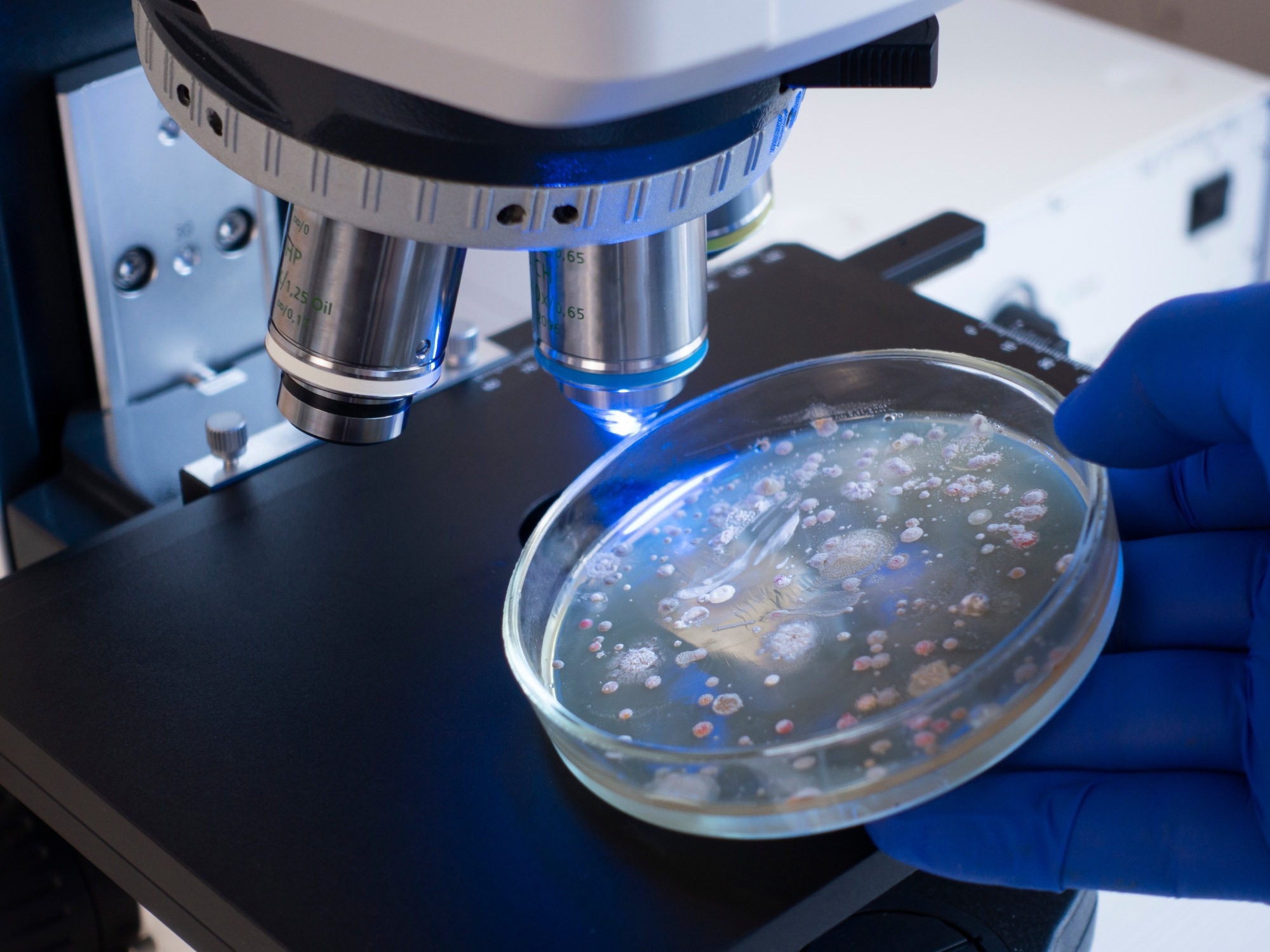In a recent study published in Cancer Cell, researchers combined deep microbial sequencing and targeted culturing of bacteria with in vitro assessments to investigate tumor and gut microbiome traits that impact chemoradiation therapy in patients with cervical cancer.
 Study: Tumor-resident Lactobacillus iners confer chemoradiation resistance through lactate-induced metabolic rewiring. Image Credit: Prrrettty/Shutterstock.com
Study: Tumor-resident Lactobacillus iners confer chemoradiation resistance through lactate-induced metabolic rewiring. Image Credit: Prrrettty/Shutterstock.com
Background
Cancer and immune cell signaling, metabolism, and proliferation can all be affected by active metabolites produced by tumor microbiota. Tumors, especially in germ-free organs, have distinct microbiomes influencing response to therapy and patient survival.
While gut microbes influence tumor response indirectly through immunological and metabolic pathways, tumor-resident bacterial organisms directly influence tumor development, body function, and patient survival.
Detailed mechanistic investigation of tumor microbes, on the other hand, remains a considerable difficulty concerning most tumor types.
About the study
In the present study, researchers investigated the potential pathways of direct cancer-microbiota interactions during oncolytic therapy for cervical cancers using deep sequencing, targeted bacterial cultures, and immunological profiling.
The researchers wanted to find and analyze tumor microbiota related to treatment resistance in cervical cancer patients undergoing chemoradiation. In total, 101 individuals with incident, locally advanced cervical cancers participated in the study, of whom 96 provided samples before receiving standard therapy.
Analyses performed included 16S ribosomal ribonucleic acid (RNA) sequencing (16S), T lymphocyte repertoire sequencing (TCR), shotgun metagenome sequencing (SMS), and metabolomics.
The researchers used 16S rRNA data to perform linear discriminant analysis effect size (LEfSe) on 43 patients to determine associations with the response to chemoradiation treatment. An additional 58 patients were recruited across two institutions to validate the association between L. iners with RFS.
To investigate whether Lactobacillus iners, obtained from cervical malignancies, may generate radiation resistance without an immune response, the researchers characterized the bacterial strains from the tumors before filtering the cell-free supernatant (CFS).
Human papillomavirus 16-positive (HPV-16+) cervical squamous cell carcinoma (CSCC) cell line (CaSki) was used in serial dilution tests.
The team generated cervical tumor patient-derived organoids (PDO) with a dense three-dimensional shape, immunofluorescence patterns compatible with CSCC, and sensitivity to cisplatin therapy and ionizing radiations (IRs).
Cell viability was also examined in Henrietta Lacks (HeLa) cells following IR utilizing cancer-derived and non-cancer-derived L. crispatus. L. crispatus did not induce resistance to treatment.
Swabs and cytobrush samples of the cervical tumor were collected at five different time points: baseline, week 1.0, week 3.0, week 5.0, and the initial follow-up at week 12 post-treatment. Tumor swabs were used to obtain deoxyribonucleic acid (DNA) for TCR sequencing.
Results
Lactobacillus iners was detected in over 45% of specimens and was linked to non-response to chemotherapy and radiation treatment (CRT). In contrast, Actinobacteria, Proteobacteria, and Gammaproteobacteria were associated with CRT response.
Increased Lactobacillus iners abundance significantly reduced recurrence-free survival (RFS, multivariate analysis Cox HR 5.8, adjusting for gut microbial diversity and tumor stage); and overall survival (OS, multivariate analysis Cox hazard ratio, 13, adjusting for stage) in patients.
Advanced stage, assessed using the International Federation of Gynecology and Obstetrics (FIGO) 2009 criteria, and poorer gut microbial diversity reduced RFS.
Due to the limited number of OS events, L. iners showed significant results in the models adjusted for the evenness and diversity of the gut microflora created. Other than intestinal Simpson diversity and Pielou evenness, no other tumor or gut compositional parameters were significantly associated with Lactobacillus iners, RFS, or OS.
Unsupervised clustering identified two L. iners+ clusters associated with Gardnerella vaginalis or Atopobium vaginae and a Prevotella via-associated L. iners cluster. In cervical tumor cells, L. iners promoted chemotherapy and radiation resistance. PDOs cultured with CC-L. iners CFS grew and resisted more aggressively than controls.
L. iners treatment considerably enhanced the HeLa, SiHa, and CaSki cell viability at all irradiation levels. L. iners altered the expression of genes associated with lactate signaling and lactate dehydrogenase (LDH) levels, dramatically altering cell behavior.
L. iners was an obligatory L-lactate maker and tumors with CC-L. iners+ were enriched with L-lactate. After CFS treatment, DNA damage was found in cervical cancer cells with CC-L. iners caused significant gene expression modifications compared to NC-L. iners.
L. iners increased tumor metabolic activity in response to radiation-induced stress. L. iners+ tumors had upregulated glycolysis compared to L. iners– tumors. Tumor-derived Lactobacillus iners acquire additional genes for lactose utilization during carcinogenesis. CC-L. iners generated fewer early foci than NC-Lactobacillus iners, but both formed more initial foci than controls.
CC-L. iners also generated glucose as a byproduct, which might cause the Cdk1/Cyclin B complex to halt the gap 2 (G2)/mitosis (M) checkpoint and improve tumor survival after irradiation despite DNA damage. L. iners and related lactic acid bacteria (LAB) were found in several cancer forms, with L. iners found in anal, vaginal, vulvar, colorectal, and lung cancers but seldom in non-small cell lung cancer (NSCLC).
In all four malignancies, tumoral lacGDRA bacterial presence was strongly related to a decreased RFS. Survival was linked to obligate L- or D-lactate synthesis by genetically identical LAB.
Conclusion
Overall, the study findings showed that L. iners, a lactic acid bacterium, was associated with poor tumor response to chemoradiation and increased L-lactate synthesis in tumors, indicating that L. iners might be a promising therapeutic target for various cancers.
The microorganisms could modify tumor metabolism and lactate signaling pathways, resulting in treatment resistance. The high lactate generation of L. iners in vitro and tumors after irradiation may "prime" cervical tumor cells, amplifying the lactate feedback loop produced by oxidative stress.
Given its great commensality to cervical cancers and the cervicovaginal niche, L. iners might be utilized to deliver anticancer medications with tumor specificity.